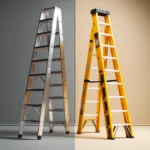Choosing the right ladder is crucial for your safety and efficiency, whether you’re tackling a home improvement project or managing tasks at work. You might have found yourself standing in a hardware store aisle, staring at two main contenders: aluminum and fiberglass ladders.
Each has its own set of benefits and drawbacks, and the choice isn’t always straightforward. But what if making the right decision could save you time, money, and even prevent potential accidents? By understanding the unique features of aluminum and fiberglass ladders, you can make an informed choice that best fits your needs.
Stick around to discover which ladder is the perfect match for your projects, ensuring you climb safely and confidently every time.
Material Properties
Aluminum ladders offer strength and durability, making them suitable for heavy-duty tasks. Fiberglass ladders provide excellent electrical insulation, ideal for electricians. Each material has distinct benefits, catering to different safety and functional needs.
When choosing between an aluminum and a fiberglass ladder, understanding the material properties is key. Each material offers unique benefits and challenges that can impact your decision. To make an informed choice, consider these aspects: strength and durability, weight and portability.Strength And Durability
Aluminum ladders are known for their robustness. They are resistant to corrosion, making them ideal for outdoor use. However, they can conduct electricity, which is something to consider if you’re working near power lines. Fiberglass ladders, on the other hand, do not conduct electricity, making them safer for electrical work. They are incredibly durable and can withstand harsh weather conditions without weakening. Yet, they may become brittle over time if exposed to sunlight for prolonged periods.Weight And Portability
Aluminum ladders are lightweight, making them easy to carry and transport. This is perfect for those who frequently move their ladders from one job site to another. However, their lightweight nature might compromise stability in windy conditions. Fiberglass ladders are generally heavier, which enhances their stability. This can be advantageous when you need a steady base to work from. But the added weight can make them cumbersome to transport, especially for solo workers. Have you ever tried to carry a ladder by yourself? It’s no easy feat! Imagine lugging a heavier fiberglass ladder across a large yard. The trade-off between weight and stability is something to ponder when making your choice. Would you prefer the ease of an aluminum ladder or the sturdy reliability of fiberglass?
Credit: www.laddersukdirect.co.uk
Safety Features
Choosing the right ladder for your needs involves understanding the safety features of each type. When comparing aluminum and fiberglass ladders, it’s essential to recognize their unique safety benefits. A ladder’s safety features can significantly impact your work efficiency and personal safety. Let’s dive into the specifics and see how these materials measure up.
Conductivity And Insulation
Electricity is a silent danger you might not always see. Aluminum ladders are known for their electrical conductivity, which can be risky in environments with live wires. Imagine accidentally touching a wire while climbing an aluminum ladder—it’s not a pleasant thought.
Fiberglass ladders, on the other hand, offer excellent insulation. If you work around electrical installations, fiberglass is your friend. It doesn’t conduct electricity, providing a safer option for electricians and DIY enthusiasts alike. This simple choice could save your life.
Slip Resistance
Ever slipped off a ladder and felt your heart race? Slip resistance is a critical safety feature. Aluminum ladders often come with textured rungs to reduce the risk of slipping, but they can get slick if wet. It’s something to think about if you’re working in damp conditions.
Fiberglass ladders typically have superior slip-resistant rungs. They offer better grip, even when conditions are less than ideal. Picture yourself climbing confidently, knowing your ladder won’t let you down. Isn’t it reassuring to know you can focus on the task, not just staying safe?
In conclusion, when selecting a ladder, consider these safety features carefully. Reflect on your work environment and the potential hazards you face. What ladder ensures you return home safely after a day’s work?
Cost Considerations
Choosing between aluminum and fiberglass ladders involves several cost factors. Understanding these can help make a wiser decision. Consider initial investment and maintenance costs.
Initial Investment
Aluminum ladders typically have a lower price tag. They offer affordability and are widely available. Fiberglass ladders are generally more expensive. Their price reflects durability and safety features. For budget-conscious buyers, aluminum may seem more appealing. Those prioritizing performance might lean towards fiberglass.
Maintenance Costs
Aluminum ladders require minimal maintenance. They resist rust and corrosion, reducing upkeep expenses. Fiberglass ladders need more care. Exposure to harsh elements can affect their condition. Regular checks and repairs might be necessary. Consider these factors when planning long-term costs.
Environmental Impact
When choosing between aluminum and fiberglass ladders, the environmental impact can be a significant factor. Both materials offer unique benefits and challenges to the environment. Understanding these aspects can guide you to make a choice that aligns with your values.
Sustainability
Aluminum ladders have a positive impact when it comes to sustainability. Aluminum is abundant in nature and can be extracted with relatively low energy compared to other metals. It’s also lightweight, which means less fuel is needed to transport it.
On the other hand, fiberglass is derived from petroleum products, which are non-renewable. This process requires more energy and resources. If sustainability is a priority for you, consider how these factors align with your environmental goals.
Recyclability
Aluminum shines in recyclability. It can be melted down and reused multiple times without losing quality. Recycling aluminum uses only 5% of the energy required to produce new aluminum. This makes it a powerhouse in reducing waste.
Fiberglass, however, faces challenges. Recycling fiberglass is not straightforward. The process can be expensive and complex. This often leads to fiberglass ladders ending up in landfills, contributing to waste. As a consumer, think about how the end-of-life of your ladder impacts the planet.
Have you ever considered how your choice in tools affects the environment? Next time you shop for a ladder, weigh the sustainability and recyclability of the materials. Every choice counts.
Applications
Choosing the right ladder depends on its intended applications. Aluminum and fiberglass ladders have distinct uses. Each offers benefits that suit specific tasks. Understanding these differences helps in making informed decisions.
Residential Use
Aluminum ladders are lightweight. They are easy to move around the house. Ideal for indoor tasks like painting or cleaning. They resist rust, making them suitable for moist environments.
Fiberglass ladders excel in safety. They are non-conductive, perfect for electrical work. This safety feature is crucial for tasks involving wiring. Fiberglass also withstands harsh weather. It is great for outdoor tasks like trimming trees.
Commercial Use
In commercial settings, aluminum ladders offer durability. They are often used in construction. Their lightweight nature aids in quick relocation. This efficiency is essential on fast-paced job sites.
Fiberglass ladders are preferred in industries with electrical hazards. Their non-conductive properties ensure worker safety. They are robust, handling heavy-duty tasks with ease. Maintenance crews often select fiberglass for its reliability.

Credit: www.youtube.com
User Preferences
Choosing between aluminum and fiberglass ladders depends on user preferences. Different users value different features. Comfort, ease of use, and ergonomics play significant roles. Understanding these aspects can guide users to the right choice.
Comfort And Ergonomics
Comfort is crucial for ladder users. Aluminum ladders are lightweight. This feature makes them easier to handle. Users often appreciate this aspect. In contrast, fiberglass ladders are heavier. This might cause fatigue over extended use. Some users prefer the sturdiness of fiberglass. It feels more secure. Both materials offer unique benefits.
Ease Of Use
Ease of use is another factor. Aluminum ladders are easier to carry. Their lightweight nature helps in transport. Users find them simple to set up. Fiberglass ladders require more effort. They are heavier and less portable. Yet, they provide better insulation. This feature is vital for electrical work. Users must consider their specific needs. Each ladder type offers distinct advantages.
Market Trends
Choosing between aluminum and fiberglass ladders? You’re not alone. The market’s buzzing with options and innovations, making this decision more intriguing than ever. While both ladder types have their merits, the current trends offer insights into their popularity and availability, as well as the latest innovations that might influence your choice.
Popularity And Availability
Aluminum ladders enjoy widespread popularity due to their lightweight nature. You might have noticed them in most hardware stores or even your neighbor’s garage. They are easy to carry around and can withstand the elements, making them a favorite for outdoor projects.
Fiberglass ladders, on the other hand, are gaining traction. Their non-conductive properties make them perfect for electrical work. But are they as readily available as aluminum? While their presence is growing, they might not be as ubiquitous, especially in smaller stores. Yet, their demand is rising, which could soon change the landscape.
Innovations
Manufacturers are constantly pushing the envelope with ladder designs. Have you seen the new multi-position ladders? They offer flexibility and cater to different projects, blending the best of both aluminum and fiberglass features.
Aluminum ladders are embracing tech, with smart designs that focus on user safety and convenience. Imagine a ladder with built-in safety sensors – not too far-fetched with today’s technology. Innovations in fiberglass ladders focus on enhancing durability and user comfort, perhaps soon becoming the norm in professional settings.
So, where do you see the future of ladders? Will aluminum continue its reign, or will fiberglass become the go-to choice? As trends evolve, keeping an eye on these innovations could make all the difference in your next ladder purchase.

Credit: laddersafetyrails.com
Frequently Asked Questions
What Are The Benefits Of Aluminum Ladders?
Aluminum ladders are lightweight and resistant to rust. They are easy to carry and durable for long-term use.
How Do Fiberglass Ladders Ensure Safety?
Fiberglass ladders do not conduct electricity. This makes them safe for electrical work and reduces the risk of shocks.
Which Ladder Is More Durable, Aluminum Or Fiberglass?
Fiberglass ladders are generally more durable than aluminum. They can withstand harsh weather and heavy-duty use better.
Are Fiberglass Ladders Heavier Than Aluminum Ladders?
Yes, fiberglass ladders are heavier. This can make them more stable but harder to transport.
What Factors Should I Consider When Choosing A Ladder?
Consider the ladder’s weight, durability, safety, and purpose. Match the ladder type to the task you need to complete.
Conclusion
Choosing the right ladder depends on your specific needs. Aluminum ladders offer strength and are lightweight. They resist rust well. Fiberglass ladders provide excellent insulation. They are ideal for electrical work. Consider the ladder’s weight capacity and height. Also, think about where you’ll use it most.
Safety should always be a top priority. Both types have their advantages. It’s about matching the ladder to your tasks. Make sure to store your ladder properly. This will ensure longevity and safety. Always inspect your ladder before use. Happy climbing!





